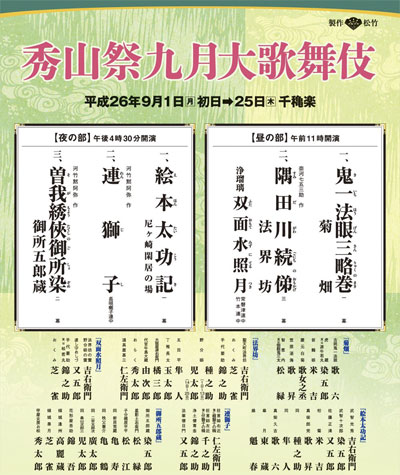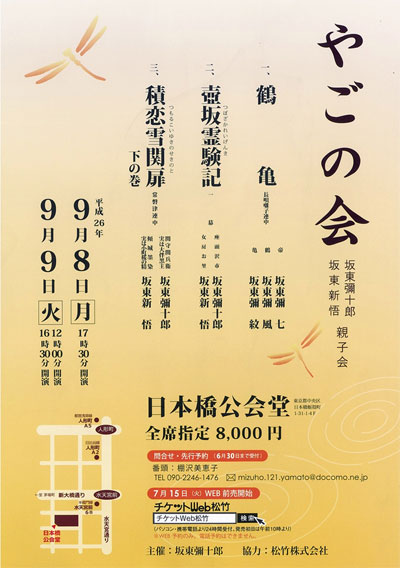| Comments |
This is the 7th edition in T˘ky˘ of a special program called "Shűzan Matsuri" (the festival of Shűzan), which is produced at the Kabukiza
to commemorate the great actor Nakamura Kichiemon I, whose's haimy˘ was Shűzan.
The star of this program is his adopted son, the Living National Treasure Nakamura Kichiemon II.
Kikubatake: it is a great classic of period play Kabuki originally adapted from the Bunraku puppet theatre,
full of larger-than-life characters and a stage full of dazzling color.
In a garden of brilliant yellow and white chrysanthemums, there is Kiichi (Nakamura Karoku),
an elderly strategist working for the dictator Kiyomori, his beautiful daughter
Minazuru (Nakamura Yonekichi) and two footmen, the elegant young Toraz˘ (Ichikawa Somegor˘) and the
powerful Chienai (Onoe Sh˘roku). But in fact, Toraz˘ is a young general from the enemy
side here to steal Kiichiĺs secrets of strategy. Chienai is his retainer.
But Kiichi has realized why they are there and also knows that Chienai
is actually his younger brother. At the same time, Minazuru has fallen
deeply in love with Toraz˘.
H˘kaib˘: a full-length performance of a comic play featuring the
antics of an evil begging priest named H˘kaib˘. In this case, it is a special
version of this Kabuki classic staged by modern theater director Kushida Kazuyoshi.
H˘kaib˘ (Living National Treasure Nakamura Kichiemon) is in love with the beautiful, young Okumi (Nakamura Shibajaku) who is
herself in love with Y˘suke, a servant at her father's store. Y˘suke (Nakamura Kinnosuke)
is actually an aristocrat searching for the lost treasure of his family.
He regains possession only to have the scroll stolen by H˘kaib˘.
Y˘suke accepts Okumi's love, but is also pursued by Princess Nowake (Nakamura Tanenosuke up to the 13th of September, Nakamura Kotar˘ from the 14th of September),
his true fiancee. In a grim but humorous scene at a graveyard, everyone tries to
get Okumi and the scroll. But H˘kaib˘ ends up killing Princess Nowake and is
killed himself before he can enjoy the fruits of his villainy.
The last scene, "Futa Omote Mizu ni Terutsuki", is one of the great classics of dance and is often performed
separately. Y˘suke and Okumi try to run off together only to find a
strange figure that looks exactly like Okumi.
Y˘suke tries to find out which is the real Okumi.
In fact, in a virtuoso turn for the star actor who plays
this double role, the mysterious figure is made up of the combined spirits
of H˘kaib˘ and Princess Nowake, each questing for love even after death.
Featuring also Kataoka Nizaemon as Jinzabur˘.
Amagasaki Kankyo: Akechi Mitsuhide (known in this play as Takechi Mitsuhide) is known as the "three day ruler of Japan", having only control
for a brief time after attacking and killing Oda Nobunaga (known in this play as Harunaga) and before being
defeated in turn by Toyotomi Hideyoshi (known in this play as Mashiba Hisayoshi).
In the most famous act of this play, after assassinating Harunaga, Mitsuhide comes to see his mother,
but she refuses to forgive him for betraying his lord. Mitsuhide sees his son and mother both die before
his eyes as he tries to defeat his rival Hisayoshi, but instead is confronted with the drama of his own
immediate family. Starring Living National Treasure Nakamura Kichiemon and Nakamura Karoku as Mitsuhide and Hisayoshi.
Featuring also Nakamura Kaishun, Ichikawa Somegor˘, Nakamura Yonekichi, Nakamura T˘z˘ and Nakamura Matagor˘
as Mitsuhide's wife Misao, Mitsuhide's son Jűjir˘, Jűjir˘'s fiancee Hatsugiku, Mitsuhide's mother Satsuki and Sat˘ Masakiyo.
Renjishi: 2 entertainers dance a tale of the legendary shishi or lion-like spirits that live at the foot of a
holy Buddhist mountain. There is a comic interlude with 2 Buddhist pilgrims. Then, the shishi themselves appear and perform their dance with wild shaking of their long manes.
The dance shows a parent shishi forcing his cub to undergo harsh training in order to grow up strong.
This theme is often associated with the training a parent actor gives his son.
This performance features Kataoka Nizaemon in the role of the parent shishi and
his grandson Kataoka Sennosuke in the role of the cub. Featuring also Nakamura Kinnosuke and Nakamura Matagor˘.
Gosho no Goroz˘: a portrait of the Yoshiwara
pleasure quarters at the height of its splendor. Rival gangs dressed
in the height of fashion exchange stately speeches before fighting
in the elaborate poetic cadences of Kawatake Mokuami, the last great playwright of Kabuki.
Goroz˘ is the handsome leader of a gang, but his lover, the top courtesan
Satsuki pretends to reject him to save his life. Tragedy strikes when Goroz˘
is driven to revenge. Starring Ichikawa Somegor˘ as Goroz˘, Onoe Sh˘roku as his rival in love,
Nakamura Shibajaku as Goroz˘'s lover, the courtesan Satsuki and Ichikawa Komaz˘ as ďshű,
a courtesan who is tragically killed. Featuring also Kataoka Hidetar˘, Nakamura Kikaku, Nakamura Matsue and Matsumoto Kingo.
Sources: Earphone Guide Website or Sh˘chiku Kabuki Official Website
|



